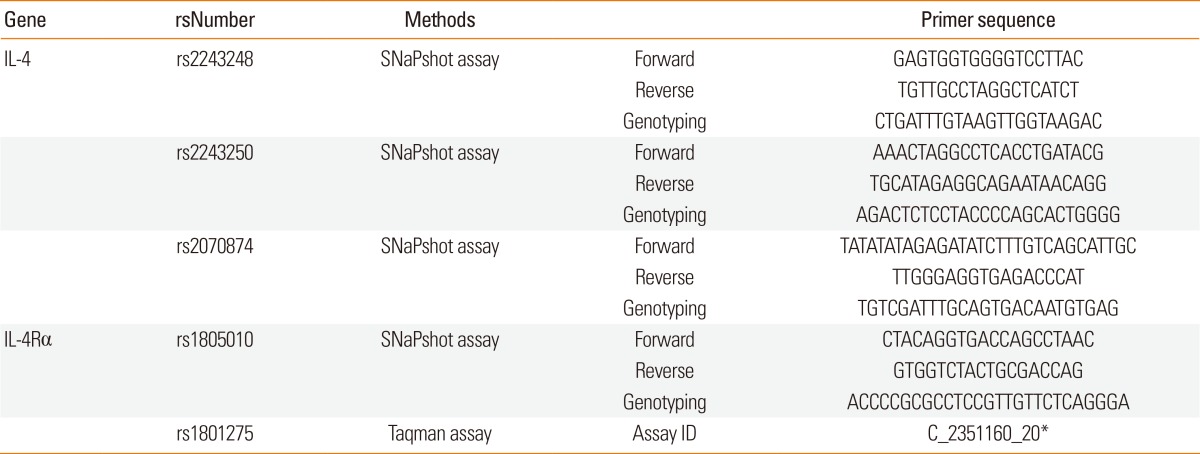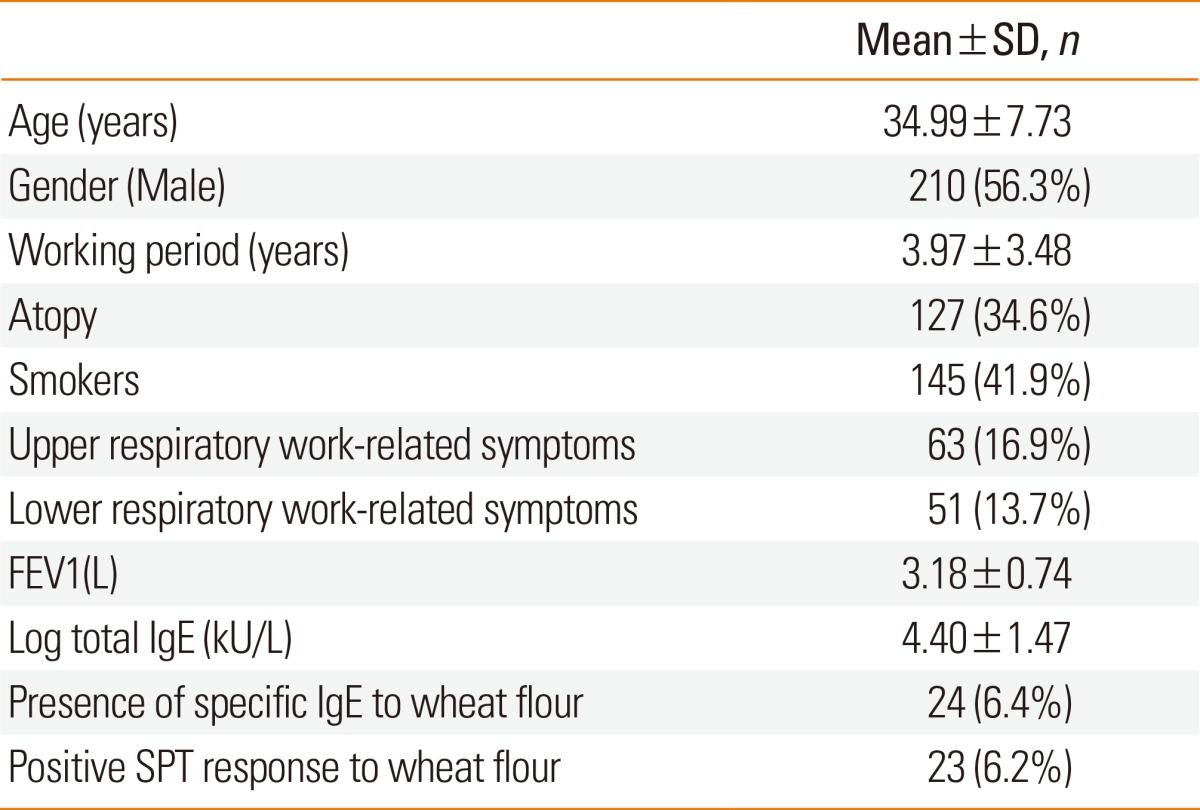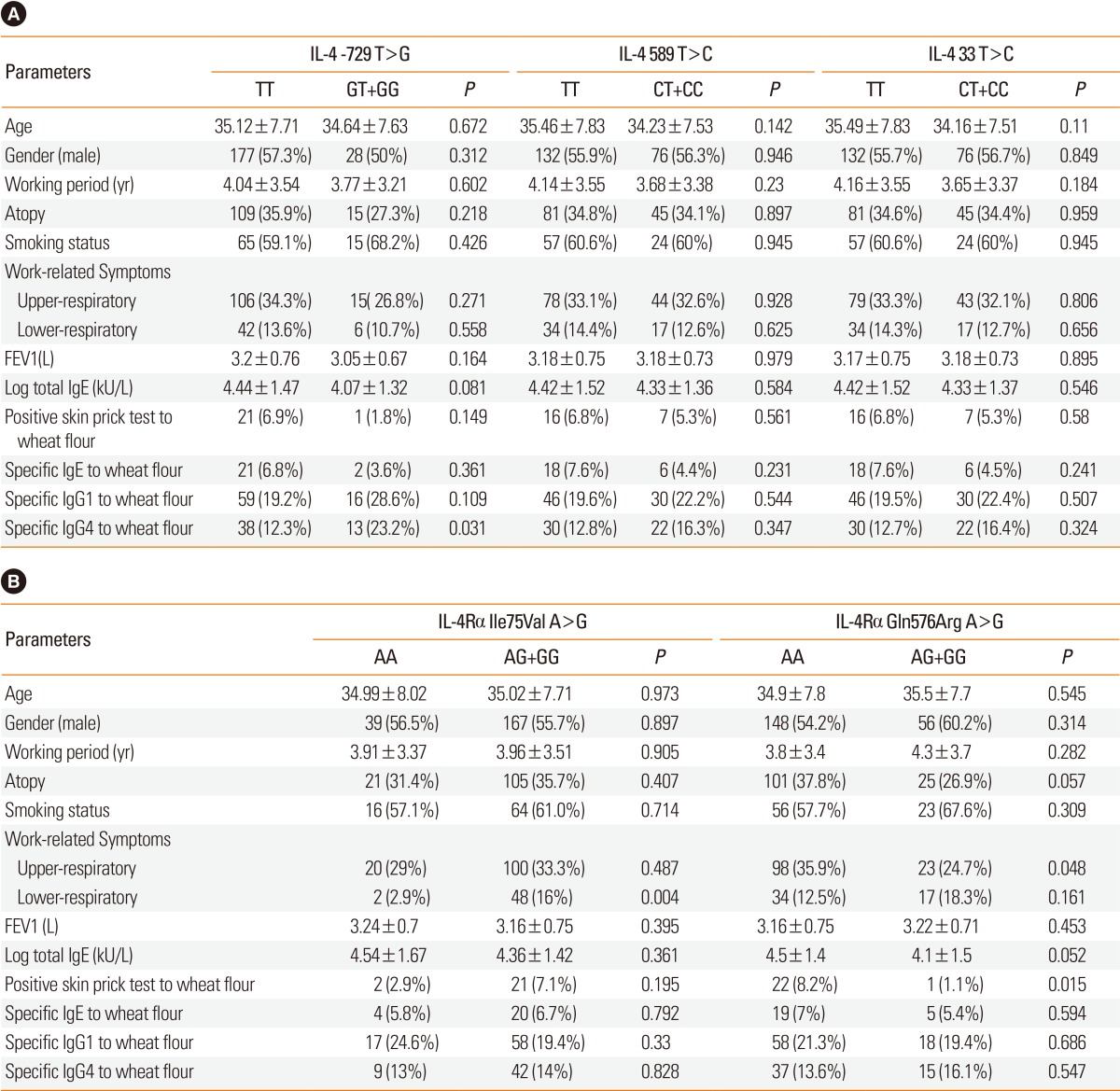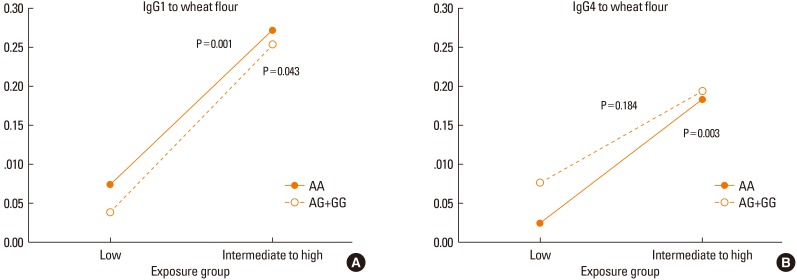Abstract
Purpose
The IL-4 and IL-4 receptor α (IL-4Rα) genes are the key candidate genes for atopy and asthma susceptibility. Exposure to wheat flour can cause IgE sensitization and respiratory symptoms in bakery workers. Therefore, we hypothesized that IL-4 and IL-4Rα single nucleotide polymorphisms (SNPs) may be involved in the pathogenic mechanism of baker's asthma.
Methods
Clinical and genetic data from 373 bakery workers were analyzed. A survey questionnaire, spirometry, and skin prick tests with wheat flour were performed. Serum-specific IgE, IgG1, and IgG4 to wheat flour were determined using ELISA. Five candidate IL-4 (-729 T>G, 589 T>C, and 33 T>C) and IL-4Rα (Ile75Val A>G and Gln576Arg A>G) SNPs were genotyped and analyzed.
Results
Workers with the G allele of IL-4Rα Ile75Val A>G had a significantly higher prevalence of work-related lower respiratory symptoms than those with the AA genotype (P=0.004, 16.0% vs. 2.9%). In the skin prick test, workers with the AA genotype of IL-4Rα Gln576Arg A>G had a significantly higher positive rate to wheat flour (P=0.015, 8.2% vs. 1.1%) than those with AG/GG genotype. No significant associations were found in the three genetic polymorphisms of IL-4. For the predicted probabilities, workers with the AA genotype of Gln576Arg A>G had a higher prevalence of IgG1 and IgG4 in response to wheat flour, according to increased exposure intensity (P=0.001 for IgG1 and P=0.003 for IgG4).
Conclusions
These findings suggest that the IL-4Rα Ile75Val and Gln576Arg polymorphisms may be associated with work-related respiratory symptom development.
Keywords: Genetic polymorphism, IL-4 Receptor α, IL-4, baker's asthma, work-related symptom
INTRODUCTION
Interleukin-4 (IL-4), one of the most important mediators of allergic inflammation, is produced by Th2 cells and mast cells.1 IL-4 and IL-13 are the key cytokines that induce IgE production, and promote differentiation of Th0 cells into Th2 cells.2 Therefore, there have been several reports demonstrating that IL-43,4 and IL-135,6 genetic polymorphisms are associated with the development of asthma and atopy. IL-4 and IL-13 are both located at chromosome 16, bind to their receptors, and share the α chain of the IL-4 receptor (IL-4Rα) to activate STAT6 and induce Th2 differentiation. They also lead to airway inflammation, airway hyper-responsiveness, mucus production, atopy susceptibility.7,8
Baker's asthma is the most prevalent type of occupational asthma worldwide.9 Although the pathogenic mechanism of baker's asthma is not fully understood, the IgE-mediated response is the major pathogenic mechanism because exposure to wheat flour can induce IgE sensitization and respiratory symptoms, leading to the development of baker's asthma.10 However, a previous study suggested that the production of serum-specific IgG4 in response to wheat flour was associated with work-related respiratory symptoms in exposed workers,11 in which genetic polymorphisms of a few candidate genes, such as adrenergic receptor β2 (ADRB2) or TLR4,12 were associated with the development of work-related respiratory symptoms and/or specific IgG4 production in highly exposed workers.13
In the present study, we analyzed genetic polymorphisms of IL-4 and IL-4Rα in association with clinical and immunological findings to further understand the pathogenic mechanism of baker's asthma in bakery workers.
MATERIALS AND METHODS
Study population
Among 392 bakery workers identified in a previous study,11 373 workers participated in this study. All subjects agreed to provide whole blood samples for genetic analyses, and they completed a respiratory questionnaire regarding whether they had experienced work-related upper- or lower-respiratory symptoms. The workers who had rhinitis symptoms such as runny nose, sneezing and congestion, which were aggravated during work and relieved after work or during holiday periods, were defined as having work-related upper-respiratory symptoms. And workers who had asthma-like symptoms such as shortness of breath, wheezing, which were also aggravated or relieved according to working periods, were defined as having work-related lower-respiratory symptoms. To define atopy status, skin prick tests (SPTs) to common inhalant allergens and serum total IgE levels were measured (ImmunoCAP system, Phadia AB, Uppsala, Sweden). SPTs for wheat flour were also performed. Serum-specific IgE, IgG1, and IgG4 in response to wheat flour were detected using enzyme-linked immunosorbent assays (ELISA), as described previously.14 The exposure environment for all subjects was classified using a device that measured individual dust exposure density as described previously.11 The Ajou University Institute Review Board reviewed and approved the study protocols. Informed consent was obtained from each participant.
Genotyping
Genomic DNA was prepared from whole blood samples using a Puregene DNA purification kit (Gentra Systems, Minneapolis, MN, USA) according to the manufacturer's protocol. We selected three SNPs of IL-4 (-729 T>G [rs2243248], -589 T>C [rs2243250], and -33 T>C [rs2070874]) and two SNPs of IL-4Rα (Ile75Val A>G [rs1805010] and Gln576Arg A>G [rs1801275]). They were genotyped using a single-base extension method and the SNaPshot ddNTP primer extension kit (Applied Biosystems, Foster City, CA, USA). Genotyping of Gln576Arg A>G for IL-4Rα was screened using the Taqman assay (Assay ID, C_2351160_20; Applied Biosystems). The primer sequences used for IL-4 and IL-4Rα SNP genotyping are listed in Table 1. The results were analyzed using the ABI Prism GeneScan and Genotyper software (Applied Biosystems).
Table 1.
Primer sequences for SNP genotyping

*Taqman assays were performed using a predesigned primer sequence according to the manufacturer's protocol.
Statistical analyses
All data are expressed as the mean±standard deviation of the mean. SPSS software (version 11.05; SPSS Inc., Chicago, IL, USA) was used for statistical analyses. Significant departures of the genotype frequency from Hardy-Weinberg equilibrium at the polymorphic site were tested by χ2 analysis. The clinical parameters of subjects were compared to each genotype using Pearson's χ2 test and Student's t-test. Predictive probability was calculated for the presence of serum-specific IgG subclasses in response to wheat flour in subjects with the IL-4Rα Gln576Arg A>G polymorphism using logistic regression.15 All data were adjusted by age, sex, atopy status, and exposure density using logistic regression.
RESULTS
Subject characteristics and clinical findings
Table 2 summarizes the demographic and clinical findings of the study participants. The mean age was 34.9±7.73 years, and 56.3% of the subjects were male. They had worked in the bakery industry for an average of 3.97±3.48 years. A total of 127 (34.6%) were atopics, and smoking prevalence was 41.9%. Among the study subjects, 63 (16.9%) had suffered from work-related upper-respiratory symptoms, whereas 51 (13.7%) had experienced work-related lower-respiratory symptoms. The mean lung function of the subjects was 3.18±0.74 L (forced expiratory volume in 1 s, FEV1), and the mean total IgE level was 4.40±1.47 kU/L. The prevalence of serum-specific IgE antibody in response to wheat flour was 6.4%, and 6.2% of participants had positive SPT results for wheat flour.
Table 2.
Clinical characteristics of the subjects (n=373)

SPT, Skin prick test.
Associations between genetic polymorphisms and clinical parameters
The genetic association of each SNP with the clinical parameters is shown in Table 3. No significant associations were found between the three IL-4 SNPs (-729 T>G, 589 T>C, 33 T>C) and any of the clinical parameters tested, as shown in Table 3A. However, significant associations were observed with the two IL-4Rα SNPs (Ile75Val A>G and Gln576Arg A>G), as shown in Table 3B. Subjects with the G allele of IL-4Rα Ile75Val A>G had a significantly higher prevalence of work-related lower-respiratory symptoms (P=0.004). Subjects with the mutant A allele at Gln576Arg A>G of IL-4Rα had a significantly higher prevalence of work-related upper-respiratory symptoms (P=0.048). In addition, subjects with the AA genotype showed a significantly higher positive SPT rate in response to wheat flour (P=0.015).
Table 3.
Associations between clinical and immunologic parameters and IL-4 (A) and IL-4Rα (B) genotypes

Predictive probabilities for serum-specific IgE or IgG subclasses in response to wheat flour
As shown in Table 3B, no significant associations were found in the presence of serum-specific IgE, IgG1, and IgG4 antibodies in response to wheat flour according to the genotype of two IL-4Rα SNPs. The predicted probabilities for the presence of serum-specific antibodies in response to wheat flour were analyzed according to the exposure intensity (minimal and intermediate to high) using a logistic regression model as shown in Figure A and B. Subjects with the AA genotype of IL-4Rα Gln576Arg A>G had a significantly higher prevalence of serum-specific IgG1 and IgG4 antibodies in response to wheat flour upon increasing exposure density (Figure, P=0.001 and P=0.003 for IgG1 and IgG4, respectively), whereas the specific IgG1 response tended to increase in subjects with the G allele upon increasing exposure density to wheat flour (P=0.043, Figure A). No significant differences were observed in the serum-specific IgE response according to each genotype of IL-4Rα and IL-4.
Figure.
Predictive probabilities for the Gln576Arg G>A polymorphism in IL-4Rα and the presence of serum-specific IgG1 (A) and IgG4 (B) antibodies in response to wheat flour related to exposure density.
DISCUSSION
Various studies have investigated the potential associations between IL-4Rα polymorphisms in asthma and allergic disease, with some conflicting results. Most studies revealed that variants of IL-4Rα SNPs contribute to increased risk of asthma and allergic disease along or in combination with other genes. In child16-18 and adult19,20 asthmatics, there have been several reports on the positive association between IL-4Rα polymorphisms (Ile50Val, rs1805010; Arg551Gln, Q576R, Gln576Arg, rs1801275; Glu375Ala, rs1805011; and Ser411Leu, rs1805013) and asthma susceptibility. In patients with atopic dermatitis, an IL-4Rα polymorphism (Ile50Val, rs1805010) is also associated with increased susceptibility.21 Furthermore, using a meta-analysis, Loza et al.22 revealed that a variant allele of the Q576R (rs1801275) IL-4Rα polymorphism is associated with a significant risk of atopic asthma. Based on these previous results of IL-4Rα polymorphisms, we selected two candidate SNPs, Ile50Val (rs1805010), and Arg551Gln (rs1801275), which have been found to have a significant association with asthma susceptibility. In the present study, we also found that these SNPs are associated with the development of work-related symptoms and positive SPTs in response to wheat flour. These findings suggest that IL-4Rα polymorphisms may contribute to the development of baker's asthma in wheat-exposed workers.
The genetic polymorphism of the Ile75Val SNP has previously been reported to be associated with asthma susceptibility in a Chinese pediatric asthma population.18 Another study showed that variants of the Ile75Val SNP are associated with asthma susceptibility through gene-gene interactions in a cohort of Taiwanese school children.17 In addition, the Ile75Val polymorphism may be associated with an increased risk of β-lactam allergy in atopic women.23 These previous data are comparable to our findings because they show that variants of the Gln576Arg (rs1801275) polymorphism of IL-4Rα are related to higher asthma and allergic disease susceptibility.16,18 In the present study, the Ile75Val polymorphism is associated with a higher prevalence of work-related respiratory symptoms in exposed bakery workers (Table 3B, P=0.004). A possible mechanism is that the Gln576Arg polymorphism may promote asthma development by augmenting IL-4Rα-dependent signaling, which has been demonstrated by several experimental24 and human studies.25 Regarding the genetic polymorphism of the IL-4 Gln576Arg polymorphism, the Q576 allele was significantly prevalent in patients with penicillin allergy, and was associated with increased serum-specific IgE levels in response to penicillin.26 Other studies have demonstrated that variants of the Gln576Arg polymorphism are associated with lower total IgE levels in healthy adults27 and family members with atopic children,28 confirmed by in vitro analyses. In the present study, the GG genotype at the Gln576Arg polymorphism was significantly associated with a positive SPT in response to wheat flour, although the association between the Gln576Arg polymorphism and serum-specific IgE levels in response to wheat flour did not reach statistical significance. Considering that the IgE-mediated response is a major mechanism in the pathogenesis of baker's asthma, and that the results of the SPTs conducted in the present study in response to wheat were correlated with serum-specific IgE in response to wheat flour in our previous study,11 the genetic polymorphism at IL-4Rα Gln576Arg A>G may be a genetic risk factor that increases IgE sensitization to wheat in exposed workers, and could thus contribute to work-related respiratory symptoms and baker's asthma.
The IL-4Rα polymorphism at Gln576Arg A>G had a significantly higher prevalence of serum-specific IgG1 and IgG4 in response to wheat, upon increasing exposure intensity. Our previous study showed that serum-specific IgG subclasses in response to wheat flour were associated with work-related respiratory symptoms.11 Moreover, a β-adrenergic receptor genetic polymorphism was associated with specific IgG production and the development of work-related respiratory symptoms in one aspect of gene-environment interaction.13 The current study provides more evidence showing a possible gene-environment association in the development of baker's asthma. A few studies have suggested a possible gene-environment interaction in the development of occupational asthma.9 The HLA class II molecules, which are involved in the presentation of processed antigens to T lymphocytes, might have a critical role in these associations. Therefore, most genetic susceptibility studies in occupational asthma have focused on low-molecular-weight antigens.29,30 The genetic polymorphisms of IL-4, IL-13, and IL-4Rα have been found to be associated with a susceptibility to isocyanate-induced occupational asthma.31 However, this is the first study to investigate a gene to environmental interaction with exposure of high-molecular-weight antigens in an occupational exposure setting. The previous studies showed significant associations between several candidate genes, including β2-adrenergic receptor,13 TLR4,12 and IL-1832 in association with work related symptoms or immunologic findings in bakery workers. In the present study, we found significant associations of IL-4 and IL-4Rα genetic polymorphism with work-related respiratory symptoms and positive SPTs to wheat in a single cohort of bakery workers, which may provide a possible clue of gene to environmental association in bakery workers.
In conclusion, our findings suggest that two genetic polymorphisms (Ile75Val and Gln576Arg G>A) of IL-4Rα may be associated with work-related respiratory symptoms and serum-specific antibody production in bakery workers, which may contribute to the development of bakers' asthma.
ACKNOWLEDGEMENTS
This study is supported by the National Research Foundation (NRF), a grant from the Korean government (MEST 213-003341).
Footnotes
There are no financial or other issues that might lead to conflict of interest.
References
- 1.Del Prete G. Human Th1 and Th2 lymphocytes: their role in the pathophysiology of atopy. Allergy. 1992;47:450–455. doi: 10.1111/j.1398-9995.1992.tb00662.x. [DOI] [PubMed] [Google Scholar]
- 2.de Vries JE, Punnonen J, Cocks BG, de Waal Malefyt R, Aversa G. Regulation of the human IgE response by IL4 and IL13. Res Immunol. 1993;144:597–601. doi: 10.1016/s0923-2494(05)80009-4. [DOI] [PubMed] [Google Scholar]
- 3.Walley AJ, Cookson WO. Investigation of an interleukin-4 promoter polymorphism for associations with asthma and atopy. J Med Genet. 1996;33:689–692. doi: 10.1136/jmg.33.8.689. [DOI] [PMC free article] [PubMed] [Google Scholar]
- 4.Sandford AJ, Chagani T, Zhu S, Weir TD, Bai TR, Spinelli JJ, Fitzgerald JM, Behbehani NA, Tan WC, Pare PD. Polymorphisms in the IL4, IL4RA, and FCERIB genes and asthma severity. J Allergy Clin Immunol. 2000;106:135–140. doi: 10.1067/mai.2000.107926. [DOI] [PubMed] [Google Scholar]
- 5.Graves PE, Kabesch M, Halonen M, Holberg CJ, Baldini M, Fritzsch C, Weiland SK, Erickson RP, von Mutius E, Martinez FD. A cluster of seven tightly linked polymorphisms in the IL-13 gene is associated with total serum IgE levels in three populations of white children. J Allergy Clin Immunol. 2000;105:506–513. doi: 10.1067/mai.2000.104940. [DOI] [PubMed] [Google Scholar]
- 6.van der Pouw Kraan TC, van Veen A, Boeije LC, van Tuyl SA, de Groot ER, Stapel SO, Bakker A, Verweij CL, Aarden LA, van der Zee JS. An IL-13 promoter polymorphism associated with increased risk of allergic asthma. Genes Immun. 1999;1:61–65. doi: 10.1038/sj.gene.6363630. [DOI] [PubMed] [Google Scholar]
- 7.Rosa-Rosa L, Zimmermann N, Bernstein JA, Rothenberg ME, Khurana Hershey GK. The R576 IL-4 receptor alpha allele correlates with asthma severity. J Allergy Clin Immunol. 1999;104:1008–1014. doi: 10.1016/s0091-6749(99)70082-5. [DOI] [PubMed] [Google Scholar]
- 8.Ober C, Leavitt SA, Tsalenko A, Howard TD, Hoki DM, Daniel R, Newman DL, Wu X, Parry R, Lester LA, Solway J, Blumenthal M, King RA, Xu J, Meyers DA, Bleecker ER, Cox NJ. Variation in the interleukin 4-receptor alpha gene confers susceptibility to asthma and atopy in ethnically diverse populations. Am J Hum Genet. 2000;66:517–526. doi: 10.1086/302781. [DOI] [PMC free article] [PubMed] [Google Scholar]
- 9.Vandenplas O. Occupational asthma: etiologies and risk factors. Allergy Asthma Immunol Res. 2011;3:157–167. doi: 10.4168/aair.2011.3.3.157. [DOI] [PMC free article] [PubMed] [Google Scholar]
- 10.Baur X, Degens PO, Sander I. Baker's asthma: still among the most frequent occupational respiratory disorders. J Allergy Clin Immunol. 1998;102:984–997. doi: 10.1016/s0091-6749(98)70337-9. [DOI] [PubMed] [Google Scholar]
- 11.Hur GY, Koh DH, Kim HA, Park HJ, Ye YM, Kim KS, Park HS. Prevalence of work-related symptoms and serum-specific antibodies to wheat flour in exposed workers in the bakery industry. Respir Med. 2008;102:548–555. doi: 10.1016/j.rmed.2007.11.015. [DOI] [PubMed] [Google Scholar]
- 12.Cho HJ, Kim SH, Kim JH, Choi H, Son JK, Hur GY, Park HS. Effect of Toll-like receptor 4 gene polymorphisms on work-related respiratory symptoms and sensitization to wheat flour in bakery workers. Ann Allergy Asthma Immunol. 2011;107:57–64. doi: 10.1016/j.anai.2011.04.003. [DOI] [PubMed] [Google Scholar]
- 13.Hur GY, Park HJ, Lee HY, Koh DH, Lee BJ, Choi GS, Kim SH, Ye YM, Park HS. Association of β2-adrenergic receptor polymorphism with work-related symptoms in workers exposed to wheat flour. Yonsei Med J. 2011;52:488–494. doi: 10.3349/ymj.2011.52.3.488. [DOI] [PMC free article] [PubMed] [Google Scholar]
- 14.Bahn JW, Lee JY, Jang SH, Kim SH, Kim HM, Park HS. Sensitization to Empynase(pronase B) in exposed hospital personnel and identification of the Empynase allergen. Clin Exp Allergy. 2006;36:352–358. doi: 10.1111/j.1365-2222.2006.02434.x. [DOI] [PubMed] [Google Scholar]
- 15.Mehl A, Verstege A, Staden U, Kulig M, Nocon M, Beyer K, Niggemann B. Utility of the ratio of food-specific IgE/total IgE in predicting symptomatic food allergy in children. Allergy. 2005;60:1034–1039. doi: 10.1111/j.1398-9995.2005.00806.x. [DOI] [PubMed] [Google Scholar]
- 16.Lee SG, Kim BS, Kim JH, Lee SY, Choi SO, Shim JY, Hong TJ, Hong SJ. Gene-gene interaction between interleukin-4 and interleukin-4 receptor alpha in Korean children with asthma. Clin Exp Allergy. 2004;34:1202–1208. doi: 10.1111/j.1365-2222.2004.02015.x. [DOI] [PubMed] [Google Scholar]
- 17.Su MW, Tung KY, Liang PH, Tsai CH, Kuo NW, Lee YL. Gene-gene and gene-environmental interactions of childhood asthma: a multifactor dimension reduction approach. PLoS One. 2012;7:e30694. doi: 10.1371/journal.pone.0030694. [DOI] [PMC free article] [PubMed] [Google Scholar]
- 18.Wu X, Li Y, Chen Q, Chen F, Cai P, Wang L, Hu L. Association and gene-gene interactions of eight common single-nucleotide polymorphisms with pediatric asthma in middle china. J Asthma. 2010;47:238–244. doi: 10.3109/02770900903509099. [DOI] [PubMed] [Google Scholar]
- 19.Bottema RW, Nolte IM, Howard TD, Koppelman GH, Dubois AE, de Meer G, Kerkhof M, Bleecker ER, Meyers DA, Postma DS. Interleukin 13 and interleukin 4 receptor-alpha polymorphisms in rhinitis and asthma. Int Arch Allergy Immunol. 2010;153:259–267. doi: 10.1159/000314366. [DOI] [PubMed] [Google Scholar]
- 20.Howard TD, Koppelman GH, Xu J, Zheng SL, Postma DS, Meyers DA, Bleecker ER. Gene-gene interaction in asthma: IL4RA and IL13 in a Dutch population with asthma. Am J Hum Genet. 2002;70:230–236. doi: 10.1086/338242. [DOI] [PMC free article] [PubMed] [Google Scholar]
- 21.Tanaka T, Hitomi Y, Kambayashi Y, Hibino Y, Fukutomi Y, Shibata A, Sugimoto N, Hatta K, Eboshida A, Konoshita T, Nakamura H. The differences in the involvements of loci of promoter region and Ile50Val in interleukin-4 receptor alpha chain gene between atopic dermatitis and Japanese cedar pollinosis. Allergol Int. 2012;61:57–63. doi: 10.2332/allergolint.10-OA-0302. [DOI] [PubMed] [Google Scholar]
- 22.Loza MJ, Chang BL. Association between Q551R IL4R genetic variants and atopic asthma risk demonstrated by meta-analysis. J Allergy Clin Immunol. 2007;120:578–585. doi: 10.1016/j.jaci.2007.05.019. [DOI] [PubMed] [Google Scholar]
- 23.Guglielmi L, Fontaine C, Gougat C, Avinens O, Eliaou JF, Guglielmi P, Demoly P. IL-10 promoter and IL4-Ralpha gene SNPs are associated with immediate beta-lactam allergy in atopic women. Allergy. 2006;61:921–927. doi: 10.1111/j.1398-9995.2006.01067.x. [DOI] [PubMed] [Google Scholar]
- 24.Tachdjian R, Mathias C, Al Khatib S, Bryce PJ, Kim HS, Blaeser F, O'Connor BD, Rzymkiewicz D, Chen A, Holtzman MJ, Hershey GK, Garn H, Harb H, Renz H, Oettgen HC, Chatila TA. Pathogenicity of a disease-associated human IL-4 receptor allele in experimental asthma. J Exp Med. 2009;206:2191–2204. doi: 10.1084/jem.20091480. [DOI] [PMC free article] [PubMed] [Google Scholar]
- 25.Risma KA, Wang N, Andrews RP, Cunningham CM, Ericksen MB, Bernstein JA, Chakraborty R, Hershey GK. V75R576 IL-4 receptor alpha is associated with allergic asthma and enhanced IL-4 receptor function. J Immunol. 2002;169:1604–1610. doi: 10.4049/jimmunol.169.3.1604. [DOI] [PubMed] [Google Scholar]
- 26.Qiao HL, Yang J, Zhang YW. Relationships between specific serum IgE, cytokines and polymorphisms in the IL-4, IL-4Ralpha in patients with penicillins allergy. Allergy. 2005;60:1053–1059. doi: 10.1111/j.1398-9995.2005.00816.x. [DOI] [PubMed] [Google Scholar]
- 27.Hackstein H, Hofmann H, Bohnert A, Bein G. Definition of human interleukin-4 receptor alpha chain haplotypes and allelic association with atopy markers. Hum Immunol. 1999;60:1119–1127. doi: 10.1016/s0198-8859(99)00102-0. [DOI] [PubMed] [Google Scholar]
- 28.Kruse S, Japha T, Tedner M, Sparholt SH, Forster J, Kuehr J, Deichmann KA. The polymorphisms S503P and Q576R in the interleukin-4 receptor alpha gene are associated with atopy and influence the signal transduction. Immunology. 1999;96:365–371. doi: 10.1046/j.1365-2567.1999.00705.x. [DOI] [PMC free article] [PubMed] [Google Scholar]
- 29.Mapp CE. The role of genetic factors in occupational asthma. Eur Respir J. 2003;22:173–178. doi: 10.1183/09031936.03.00011003. [DOI] [PubMed] [Google Scholar]
- 30.Mapp CE. Genetics and the occupational environment. Curr Opin Allergy Clin Immunol. 2005;5:113–118. doi: 10.1097/01.all.0000162301.74610.21. [DOI] [PubMed] [Google Scholar]
- 31.Bernstein DI, Wang N, Campo P, Chakraborty R, Smith A, Cartier A, Boulet LP, Malo JL, Yucesoy B, Luster M, Tarlo SM, Hershey GK. Diisocyanate asthma and gene-environment interactions with IL4RA, CD-14, and IL-13 genes. Ann Allergy Asthma Immunol. 2006;97:800–806. doi: 10.1016/S1081-1206(10)60972-6. [DOI] [PubMed] [Google Scholar]
- 32.Kim SH, Hur GY, Jin HJ, Choi H, Park HS. Effect of interleukin-18 gene polymorphisms on sensitization to wheat flour in bakery workers. J Korean Med Sci. 2012;27:382–387. doi: 10.3346/jkms.2012.27.4.382. [DOI] [PMC free article] [PubMed] [Google Scholar]



